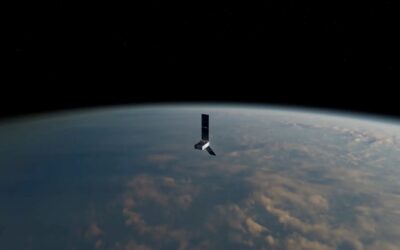
NASA will air live launch coverage of the agency’s Cislunar Autonomous Positioning System Technology Operations and Navigation Experiment (CAPSTONE), the first spacecraft to fly a specific unique lunar orbit ahead of future missions with crew.
CAPSTONE is targeted to launch no earlier than Monday, June 27, aboard a Rocket Lab Electron rocket from the company’s Launch Complex 1 in Mahia, New Zealand. The instantaneous launch opportunity is at 6 a.m. EDT (10:00 UTC). Live coverage will begin at 5 a.m. on NASA Television, the agency’s website, and the NASA app.

Team members install solar panels onto the CAPSTONE spacecraft – short for Cislunar Autonomous Positioning System Technology Operations and Navigation Experiment – at Tyvak Nano-Satellite Systems Inc.,in Irvine, California.
Credits: NASA/Dominic Hart
The destination for this microwave oven-size CubeSat is a near rectilinear halo orbit (NRHO). That same orbit is planned for Gateway, a multipurpose outpost for long-term lunar missions as part of the agency’s Artemis program.
Six days after launch, the Photon upper stage will release CAPSTONE into space for the first portion of the spacecraft’s solo flight. After a four-month journey to the Moon, CAPSTONE will test the dynamics of the NRHO for at least six months, helping reduce risk for future spacecraft. CAPSTONE will also demonstrate innovative spacecraft-to-spacecraft navigation technology and one-way ranging capabilities that could help future spacecraft fly near the Moon with reduced need for communication with Earth.
Join Virtual NASA Social
Members of the public are invited to join the virtual NASA Social to get a behind-the scenes look at CAPSTONE, learn what makes CAPSTONE unique among NASA’s missions, meet the rocket launching CAPSTONE, and more.
Visualize CAPSTONE’s Flight in Real Time
You can follow CAPSTONE’s journey live using NASA’s Eyes on the Solar System interactive real-time 3D data visualization. Starting about one week after launch, you can virtually ride along with the CubeSat with a simulated solar system view. NASA will post updates in the visualization on the agency’s Ames Research Center home page as well as Twitter and Facebook.
CAPSTONE is commercially owned and operated by Advanced Space in Westminster, Colorado, on behalf of NASA. It represents an innovative collaboration between NASA and industry to provide rapid results and feedback to inform future exploration and science missions. Tyvak Nano-Satellite Systems, a Terran Orbital Corporation, of Irvine, California, built the spacecraft. The mission also includes contributions from Stellar Exploration Inc., Space Dynamics Lab, Tethers Unlimited Inc., and Orion Space Systems.
NASA’s Small Spacecraft Technology program within the agency’s Space Technology Mission Directorate (STMD) funds the demonstration mission. The program is based at NASA’s Ames Research Center in California’s Silicon Valley. The development of CAPSTONE’s navigation technology is supported by NASA’s Small Business Innovation Research and Small Business Technology Transfer (SBIR/STTR) program, also within STMD. The Artemis Campaign Development Division within NASA’s Exploration Systems Development Mission Directorate funds the launch and supports mission operations. The Launch Services Program at NASA’s Kennedy Space Center in Florida manages the launch service. NASA’s Jet Propulsion Laboratory in Southern California supports the communication, tracking, and telemetry downlink via NASA’s Deep Space Network, Iris radio design, and groundbreaking one-way navigation algorithms.
For more information about CAPSTONE, visit:
Stay connected with the mission on social media:
- Twitter: @NASA, @NASAAmes, @NASA_Technology, @NASAArtemis, @NASA_LSP
- Facebook: NASA, NASA Ames, NASA Technology, NASA Artemis, NASA’s Launch Services Program
- Instagram: NASA, NASA Ames, NASA Artemis





